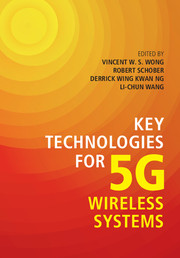Book contents
- Frontmatter
- Contents
- List of Contributors
- Preface
- 1 Overview of New Technologies for 5G Systems
- Part I Communication Network Architectures for 5G Systems
- Part II Physical Layer Communication Techniques
- Part III Network Protocols, Algorithms, and Design
- 15 Massive MIMO Scheduling Protocols
- 16 Mobile Data Offloading for Heterogeneous Wireless Networks
- 17 Cellular 5G Access for Massive Internet of Things
- 18 Medium Access Control, Resource Management, and Congestion Control for M2M Systems
- 19 Energy-Harvesting Based D2D Communication in Heterogeneous Networks
- 20 LTE-Unlicensed: Overview and Distributed Coexistence Design
- 21 Scheduling for Millimeter Wave Networks
- 22 Smart Data Pricing in 5G Systems
- Index
- References
22 - Smart Data Pricing in 5G Systems
from Part III - Network Protocols, Algorithms, and Design
Published online by Cambridge University Press: 28 April 2017
- Frontmatter
- Contents
- List of Contributors
- Preface
- 1 Overview of New Technologies for 5G Systems
- Part I Communication Network Architectures for 5G Systems
- Part II Physical Layer Communication Techniques
- Part III Network Protocols, Algorithms, and Design
- 15 Massive MIMO Scheduling Protocols
- 16 Mobile Data Offloading for Heterogeneous Wireless Networks
- 17 Cellular 5G Access for Massive Internet of Things
- 18 Medium Access Control, Resource Management, and Congestion Control for M2M Systems
- 19 Energy-Harvesting Based D2D Communication in Heterogeneous Networks
- 20 LTE-Unlicensed: Overview and Distributed Coexistence Design
- 21 Scheduling for Millimeter Wave Networks
- 22 Smart Data Pricing in 5G Systems
- Index
- References
Summary
Introduction
The rapid deployment of fourth generation (4G) Long Term Evolution (LTE) standards in wireless networks has taken place against the backdrop of an enormous increase in user demand for mobile data. Indeed, Cisco estimates that demand for mobile data grew by 74% in 2015, and predicts an eightfold increase in demand by 2020 [1]. This increase in demand has strained the capacity of even LTE networks, and has made the development of fifth generation (5G) wireless networks both difficult and important. While the LTE and IEEE 802.11 standards continue to evolve, promising an expansion in cellular network capacity, purely technological solutions may not be sufficient for meeting 5G's stated goals of supporting 1–10 Gbps connections in the field and a 10- to 100-fold increase in the number of connected devices [2, 3].
Internet service providers (ISPs) looking to meet these 5G standards are exploring a number of possible solutions that aim to integrate and co-optimize networks, devices, and applications [2]. In this chapter, we investigate smart data pricing (SDP), an approach that addresses 5G challenges as well as broader changes in the ISP ecosystem. Smart data pricing focuses on the prices that end users pay for consuming data on cellular and other types of networks. By changing these prices, we can influence users’ demands for different types of mobile data, thus allowing ISPs to improve their network performance by offloading or shifting traffic away from congested times.
SDP can help ISPs achieve their 5G performance goals while avoiding some of the costs of upgrading to new wireless standards. Deploying 5G networks will require significant upfront expenses [4], with the US Federal Communications Commission (FCC) chairman Tom Wheeler admitting that
While the FCC has taken many steps over the years and is still working to promote competition among network service providers, the fact remains that the financial barriers to building these networks are formidable, and most American consumers have few or no choices when it comes to this service.
SDP has a direct effect on ISPs’ revenues, which can help to offset these development costs. Moreover, different types of pricing can induce more robust ISP competition for users, with ISPs using prices to attract users away from their competitors.
Information
- Type
- Chapter
- Information
- Key Technologies for 5G Wireless Systems , pp. 478 - 500Publisher: Cambridge University PressPrint publication year: 2017
References
Accessibility standard: Unknown
Why this information is here
This section outlines the accessibility features of this content - including support for screen readers, full keyboard navigation and high-contrast display options. This may not be relevant for you.Accessibility Information
- 6
- Cited by
